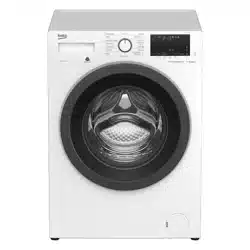Documents: Go to download!
User Manual
- User Manual - (English)
- BFL7510W - Beko - Specifications Sheet - (English)
- Intended use
- Technical specifications
- Installation
- Preparation
- Operating the product
- Maintenance and cleaning
- Troubleshooting
Table of contents
User Manual
Intended use
- This product has been designed for domestic use. It is not for commercial purposes or it should not be used out of its intended use.
- The product must only be used for washing and rinsing of laundry that are marked accordingly.
- The manufacturer waives any responsibility arisen from incorrect usage or transportation.
Technical specifications
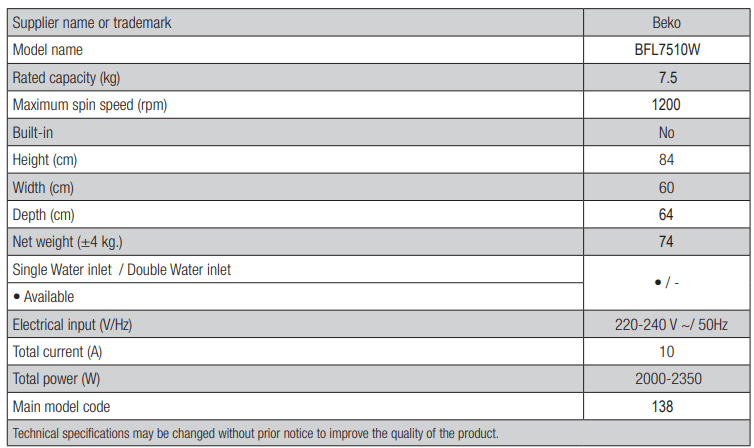
Installation
- Preparation of the location and electrical, tap water and waste water installations at the place of installation is under customer's responsibility.
- Make sure that the water inlet and discharge hoses as well as the power cable are not folded, pinched or crushed while pushing the product into its place after installation or cleaning procedures.
- Prior to installation, visually check if the product has any defects on it. If so, do not have it installed. Damaged products cause risks for your safety.
Appropriate installation location
- Place the product on a hard and level floor. Do not put it onto a carpet with high pile or other similar surfaces.
- When the washing machine and dryer are placed on top of each other, their total weight –when loaded– amounts to 180 kilograms. Place the product on a solid and flat floor that has sufficient load carrying capacity!
- Do not place the product on the power cable.
- Do not install the product in the environments where the temperature falls below 0 ºC.
- Leaving a gap at the sides of the machine is suggested to reduce vibration and noise
- On a graduated floor, do not place the product next to the edge or on a platform.
- Do not place heat sources such as Hobs, Irons, Ovens, etc. on the washing machine and do not use them on the product.
Removing packaging reinforcement (If the product has)
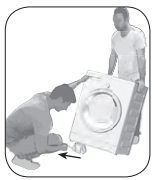
Tilt the machine backwards to remove the packaging reinforcement. Remove the packaging reinforcement by pulling the ribbon. Do not make this operation alone by yourself.
Removing the transportation locks
- Loosen all bolts with an appropriate wrench until they turn freely.
- Remove the transport safety bolts by turning them slightly.
- Insert the plastic covers in the bag containing the user manual to the openings on the rear panel.

Connecting water supply
- Tighten the nuts of the hose by hand. Never use a tool when tightening the nuts.
- When hose connection is completed, check whether there is leak roblems at the connection points by opening the taps fully. If any leaks occur, turn off the tap and remove the nut. Retighten the nut carefully after checking the seal. In order to prevent the water leaks and resultant damages, keep the taps closed when you do not use the product.
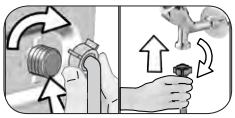
Connecting the drain hose to the drain
Attach the end of the drain hose directly to waste water drain, lavatory or bathtub
- Connect the drain hose to a minimum height of 40 cm and a maximum height of 100 cm.
- In case the drain hose is elevated after laying it on the floor level or close to the ground (less than 40 cm above the ground), water discharge becomes more difficult andthe laundry may come out excessively wet. Therefore, follow the heights described in the figure.
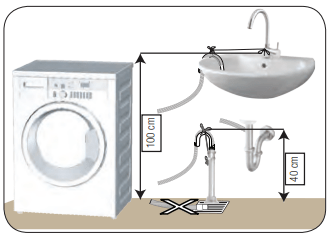
- To prevent the waste water to go back into the machine again and to ensure easy drainage, do not immerse the end of the hose into the waste water or do not insert it into the drain for more than 15 cm. If it is too long, cut it short.
- The end of the hose should not be bent, it should not be stepped on and the hose must not be pinched between the drain and the machine.
- If the length of the hose is too short, use it by adding an original extension hose. Length of the hose may not be longer than 3.2 m. To avoid water leak failures, the connection between the extension hose and the drain hose of the product must be fitted well with an appropriate clamp as not to come off and leak.
Adjusting the feet
- Loosen the lock nuts on the feet by hand.
- Adjust the feet until the product stands in a stable and balanced way.
- Tighten all lock nuts by spanner again.

Electrical connection
Connect the product to a grounded outlet protected by a 16 A fuse. The Manufacturer shall not be liable for any damages that will arise when the product is used without grounding in accordance with the local regulations.
- Connection must comply with national regulations.
- The wiring for the electrical outlet circuit must be sufficient to meet the appliance requirements. Use of a Groud Fault Circuit Interrupter (GFCI) is recommended.
- Power cable plug must be within easy reach after installation.
- If the current value of the fuse or breaker in the house is less than 16 Amps, have a qualified electrician install a 16 Amp fuse.
- The voltage specified in the "Technical specifications" section must be equal to your mains voltage.
- Do not make connections via extension cables or multi-plugs.
Initial use
Before starting to use the product make sure that the preparations are made which are in line with the "Important Safety and Environment Instructions" and the instructions in the "Installation" section.
To prepare the product for washing laundry, perform first operation in Drum Cleaning programme. If this program is not available in your machine, apply the method which is described in the section 4.4.2.

Preparation
Sorting the laundry
- Sort laundry according to type of fabric, color, and degree of soiling and allowable water temperature.
- Always observe the instructions given on the garment care labels.
Preparing laundry for washing
- Laundry items with metal attachments such as, underwiring,belt buckles or metal buttons will damage the machine. Remove the metal pieces or wash such clothes by putting them in a laundry bag or pillow case.
- Take out all substances in the pockets such as coins, pens and paper clips,and turn pockets inside out and brush. Such objects may damage the product or cause noise problem.
- Put small size clothes such as infant's socks and nylon stockings in a laundry bag or pillow case.
- Place curtains in without compressing them. Remove curtain attachment items.
- Fasten zippers,sew loose buttons and mend rips ·and tears.
- Wash “Machine washable” or “Hand washable” labeled products only with an appropriate programme.
- Do not wash colours and whites together. New, dark coloured cottons release a lot of dye. Wash them separately.
- Tough stains must be treated properly before washing. If unsure, check with a dry cleaner.
- Only use the dyes / color changers and descaling agents which are appropriate for machine wash. Always follow the instructions on the package.
- Wash trousers and delicate laundry turned inside out.
- Keep laundry items made of Angora wool in the freezer for a few hours before washing. This will reduce piling.
- Laundry that are subjected to materials such as flour, lime dust, milk powder, etc. intensely must be shaken off before placing into the product. Such dusts and powders on the laundry may build up on the inner parts of the product in time and can cause damage.
- Laundry items with metal attachments such as, underwiring,belt buckles or metal buttons will damage the machine. Remove the metal pieces or wash such clothes by putting them in a laundry bag or pillow case.
- Take out all substances in the pockets such as coins, pens and paper clips,and turn pockets inside out and brush. Such objects may damage the product or cause noise problem.
- Put small size clothes such as infant's socks and nylon stockings in a laundry bag or pillow case.
- Place curtains in without compressing them. Remove curtain attachment items.
- Fasten zippers,sew loose buttons and mend rips ·and tears.
- Wash “Machine washable” or “Hand washable” labeled products only with an appropriate programme.
- Do not wash colours and whites together. New, dark coloured cottons release a lot of dye. Wash them separately.
- Tough stains must be treated properly before washing. If unsure, check with a dry cleaner.
- Only use the dyes / color changers and descaling agents which are appropriate for machine wash. Always follow the instructions on the package.
- Wash trousers and delicate laundry turned inside out.
- Keep laundry items made of Angora wool in the freezer for a few hours before washing. This will reduce piling.
- Laundry that are subjected to materials such as flour, lime dust, milk powder, etc. intensely must be shaken off before placing into the product. Such dusts and powders on the laundry may build up on the inner parts of the product in time and can cause damage.
Tips for energy saving
Following information will help you use the product in an ecological and energy-efficient manner.
- Operate the product in the highest load capacity allowed for the programme you have selected, but do not overload. See, "Programme and consumption table".
- Observe the temperature instructions on the detergent packaging.
- Wash slightly soiled laundry at low temperatures.
- Use faster programmes for small quantities of lightly soiled laundry.
- Do not use prewash and high temperatures for laundry that is not heavily soiled or stained.
- If you plan to dry your laundry in a dryer, select the highest spin speed recommended during washing process.
- Do not use more detergent than the recommended on the detergent packaging.
Loading the laundry
- Open the loading door.
- Put the laundry items into the product in a loose manner.
- Push the loading door to close until you hear a locking sound. Ensure that no items are caught in the door. The loading door is locked while a programme is running. The door lock will open immediately after the washing programme has ended. Then you can open the loading door. If the door does not open, apply the solutions provided for "Loading door cannot be opened." error in the Troubleshooting section.
Correct load capacity
The maximum load capacity depends on the type of laundry, the degree of soiling and the desired washing programme.
The machine automatically adjusts the water amount according to the weight of the laundry put inside it.
Using detergent and softener
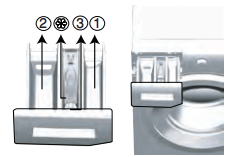
The detergent drawer is composed of three compartments:
- (1) for prewash
- (2) for main wash
- (3) for softener
 in addition, there is a siphon piece in the softener compartment.
in addition, there is a siphon piece in the softener compartment.
Detergent, softener and other cleaning agents
- Add detergent and softener before starting the washing programme.
- While the washing cycle is in progress, do not leave the detergent drawer open!
- When using a programme without prewash, do not put any detergent into the prewash compartment (compartment no. "1").
- In a programme with prewash, do not put liquid detergent into the prewash compartment (compartment no. "1").
- Do not select a programme with prewash if you are using a detergent bag or dispensing ball. Place the detergent bag or the dispensing ball directly among the laundry in the product.
- If you are using liquid detergent, do not forget to place the liquid detergent container into the main wash compartment (compartment no. “2”).
Choosing the detergent type
Detergent type to be used depends on the fabric type and color.
- Use different detergents for coloured and white laundry.
- Wash your delicate clothes only with special detergents (liquid detergent, wool shampoo, etc.) intended solely for delicate clothes.
- When washing dark coloured clothes and quilts, it is recommended to use liquid detergent.
- Wash woolens with special detergent made specifically for woolens.
Adjusting detergent amount
The amount of washing detergent to be used depends on the amount of laundry, the degree of soiling and water hardness.
- Do not use amounts exceeding the dosage quantities recommended on the detergent package to avoid problems of excessive foam, poor rinsing, financial savings and finally, environmental protection.
- Use lesser detergent for small amounts or lightly soiled clothes.
Using softeners
Pour the softener into the softener compartment of the detergent drawer.
- Do not exceed the (>max<) level sign on the softener compartment.
- If the softener has lost its fluidity, dilute it with water before adding it in the detergent compartment
Using liquid detergents
If the product contains a liquid detergent cup:
- Put the liquid detergent container into the compartment no “2”.
- If the liquid detergent lost its fluidity, dilute it with water before putting it into the detergent container
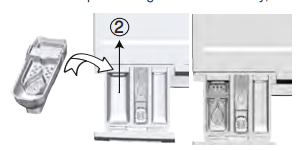
If the product is equipped with a liquid detergent part:
- When you want to use liquid detergent, pull the apparatus towards yourself. The part that falls down will serve as a barrier for the liquid detergent. If required, clean the apparatus with water when it is in place or by removing it. If you will use powder detergent, the apparatus must be secured at top position.
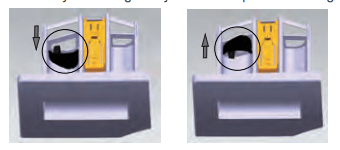
If the product does not contain a liquid detergent cup:
- Do not use liquid detergent for the prewash in a programme with prewash.
- Liquid detergent stains your clothes when used with "End Time" function to started delayed. If you are going to use the End Time function, do not use liquid detergent.
Using gel and tablet detergent
- If the gel detergent thickness is fluidal and your product does not contain a special liquid detergent container, put the gel detergent into the main wash detergent compartment during first water intake. If your product contains a liquid detergent container, fill the detergent into this container before starting the programme.
- If the gel detergent thickness is not fluidal or in the shape of capsule liquid tablet, put it directly into the drum before washing.
- Put tablet detergents into the main wash compartment (compartment no. "2") or directly into the drum before washing.
Using starch
- Add liquid starch, powder starch or the dyestuff into the softener compartment.
- Do not use softener and starch together in a washing cycle.
- Wipe the inside of the product with a damp and clean cloth after using starch.
Using limescale remover
- When required, use limescale removers manufactured specifically for washing machines only.
Using bleaches
- Select a programme with prewash and add the bleach at the beginning of the prewash. Do not put detergent in the prewash compartment. As an alternative application, select a programme with extra rinse and add the bleach while the product is taking water from the detergent compartment during first rinsing step.
- Do not use bleach and detergent by mixing them.
- Use just a little amount (approx. 50 ml) of bleach and rinse the clothes very well as it causes skin irritation.
- Do not pour the bleach onto the laundry.
- Do not use it with the colored items.
- When using an oxygen-based bleach, select a program which washes the laundry at a low temperature.
- Oxygen-based bleach can be used together with the detergent. However, if its thickness is not the same with the detergent, put the detergent first into the compartment no. "2" in the detergent drawer and wait until the detergent flows while the product is taking in water. While the product continues taking in water, add bleach in the same compartment.
Tips for efficient washing
Light Colours and Whites (Recommended temperature range based on soiling level: 40-90°C)
- Heavily Soiled (difficult stains such as grass, coffee, fruits and blood.)
- It may be necessary to pre-treat the stains or perform prewash. Powder and liquid detergents recommended for whites can be used at dosages recommended for heavily soiled clothes. It is recommended to use powder detergents to clean clay and soil stains and the stains that are sensitive to bleaches.
- Normally Soiled (For example, stains caused by body on collars and cuffs)
- Powder and liquid detergents recommended for whites can be used at dosages recommended for normally soiled clothes.
- Lightly Soiled (No visible stains exist.)
- Powder and liquid detergents recommended for whites can be used at dosages recommended for lightly soiled clothes.
Colours (Recommended temperature range based on soiling level: cold -40°C)
- Heavily Soiled (difficult stains such as grass, coffee, fruits and blood.)
- Powder and liquid detergents recommended for colors can be used at dosages recommended for heavily soiled clothes. It is recommended to use powder detergents to clean clay and soil stains and the stains that are sensitive to bleaches. Detergents which do not contain bleach should be used.
- Normally Soiled (For example, stains caused by body on collars and cuffs)
- Powder and liquid detergents recommended for colors can be used at dosages recommended for normally soiled clothes. Detergents which do not contain bleach should be used.
- Lightly Soiled (No visible stains exist.)
- Powder and liquid detergents recommended for colors can be used at dosages recommended for lightly soiled clothes. Detergents which do not contain bleach should be used.
Black/Dark Colours (Recommended temperature range based on soiling level: cold -40°C)
- Heavily Soiled (difficult stains such as grass, coffee, fruits and blood.)
- Liquid detergents suitable for colors and dark colors can be used at dosages recommended for heavily soiled clothes.
- Normally Soiled (For example, stains caused by body on collars and cuffs)
- Liquid detergents suitable for colors and dark colors can be used at dosages recommended for normally soiled clothes.
- Lightly Soiled (No visible stains exist.)
- Liquid detergents suitable for colors and dark colors can be used at dosages recommended for lightly soiled clothes.
Delicates/ Woolens/Silks (Recommended temperature range based on soiling level: cold-30°C)
- Heavily Soiled (difficult stains such as grass, coffee, fruits and blood.)
- Prefer liquid detergents produced for delicate clothes. Woolen and silk clothes must be washed with special woolen detergents.
- Normally Soiled (For example, stains caused by body on collars and cuffs)
- Prefer liquid detergents produced for delicate clothes. Woolen and silk clothes must be washed with special woolen detergents.
- Lightly Soiled (No visible stains exist.)
- Prefer liquid detergents produced for delicate clothes. Woolen and silk clothes must be washed with special woolen detergents.
Displayed Program Time
You can see the programme duration on the display of your machine while selecting a programme. Depending on the amount of laundry you have loaded into your machine, foaming, unbalanced load conditions, fluctuations in power supply, water pressure and program settings, the programme duration is automatically adjusted while the programme is running.
SPECIAL CASE: At programme start of Cottons and Cotton Eco programmes, display shows the duration of half load, which is the most common use case. After programme starts, in 20-25 minutes actual load is detected by the machine. And if the detected load is higher than half load; washing program will be adjusted accordingly and program duration increased automatically. You may follow this change on the display.

Operating the product
Control panel
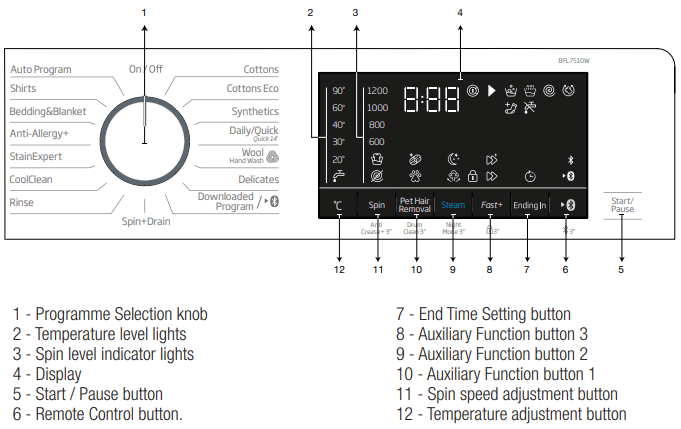
Display symbols
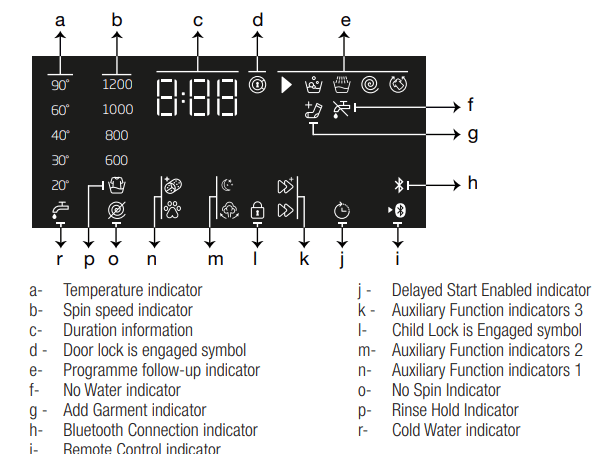
Programme and consumption table

• : Selectable.
* : Automatically selected, cannot be cancelled.
** : Energy Label programme (AS/NZS 2040)
*** : If maximum spin speed of the machine is lower then this value, you can only select up to the maximum spin speed.
**** : Programme detects the type and quantity of the laundry to automatically adjust water and energy consumption and programme time.
***** : These programmes can be used with the HomeWhiz application.
- : See the programme description for maximum load.
Programme selection
- Determine the programme suitable for the type, quantity and soiling level of the laundry in accordance with "Programme and consumption table".
- Select the desired programme with the Programme Selection knob.
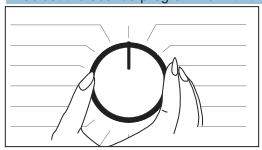
Programmes
- Cottons Eco
Use to wash your normally soiled, durable cotton and linen laundry. Although it washes longer than all other programmes, it provides high energy and water savings. Actual water temperature may be different from the stated wash temperature. When you load the machine with less laundry (e.g. ½ capacity or less), periods in programme stages may automatically get shorter. In this case, energy and water consumption will decrease more, providing a more economic wash.
Normally soiled laundry may be washed with reduced amount of detergent to save energy and protect the environment.
- Cottons
You can wash your durable cotton laundry (sheets, bedlinen, towels, bathrobes, underwear etc.) in this programme. When the Fast+ function button is pressed, programme duration becomes notably shorter but effective washing performance is ensured with intense washing movements. If the Fast+ function is not selected, superior washing and rinsing performance is ensured for your heavily soiled laundry.
- Synthetics
You can wash your laundry (such as shirts, blouses, synthetic/cotton blended fabrics etc.) in this programme.
The programme duration gets notable shorter and washing with high performance is ensured. If the Fast+ function is not selected, superior washing and rinsing performance is ensured for your heavily soiled laundry.
- Wool / Hand Wash
Use to wash your woolen/delicate laundry. Select the appropriate temperature complying with the tag of your clothes. Your laundry will be washed with a very gentle washing action in order not to damage the clothes.
- Anti-Allergy+
Use this programme for your laundry (baby clothes, bed sheets, bedlinen, underwear, etc. cotton items) that requires an anti-allergy and hygienic washing at high temperature with intensive and long washing cycle. Steam vapour is automatically applied at the beginning of the program and helps the dirt to soften easily.
- The high level of hygiene is ensured thanks to the steam application before the program, long heating duration and additional rinsing step. Vapour is distributed inside the machine during drum rotation. It is normal that steam vapour may not be visible during the cycle. Please note the Steam Function is automatically selected for this cycle and cannot be cancelled.
- Bedding & Blanket
Use this programme to wash your fiber duvets that bear "machine washable" tag. Check that you have loaded the duvet correctly in order not to damage the machine and the duvet. Remove the duvet cover before loading the duvet into the machine. Fold the duvet into two and load it into the machine. Load the duvet into the machine paying attention to place it in a way that it will not contact the bellow or the glass.
Besides, use this programme to wash your coats, vest, jackets etc. containing feathers with a "machinewashable" label on them.
- Spin+Drain
You can use this function to remove the water on the garment of drain the water in the machine.
- Rinse
Use when you want to rinse or starch separately.
- Shirts
This programme is used to wash the shirts made from cotton, synthetic and synthetic blended fabrics altogether.It reduces wrinkles. When the Fast+ function is selected, the Pre-treatment algorithm is executed.
• Apply the pre-treatment chemical on your garments directly or add it together with the detergent when the machine starts to take water in the powder detergent compartment. Thus, you can obtain the same performance as you obtain with normal washing in a much shorter period of time. Usage life of your shirts increases.
- Daily Quick / Quick 14’
Use this programme to wash your lightly soiled or unspotted cotton clothes in a short time. The programme duration can be reduced down to 14 minutes when the Fast+ function is selected. When the Fast+ function is selected, maximum 2 (two) kg of laundry must be washed.
- Dark Care / Jeans
Use this programme to protect the colour of your dark-coloured garments or jeans. It performs high performance washing with special drum movement even if the temperature is low. It is recommended to use liquid detergent or woolen shampoo for dark coloured laundry. Do not wash your delicate clothes containing wool or etc.
- Mix
Use to wash your cotton and synthetic clothes together without sorting them.
- Auto Program
Use to wash frequently washable cotton, synthetic or blended (cotton+synthetic) clothes. Programme detects the type and quantity of the laundry to automatically adjust water consumption and programme time.
The maximum washing temperature in Automatic programme depending on the soiling level and laundry type is 60ºC. Washing performance may not be at the desired level for heavily soiled whites and stubborn stains (collar, sock soil, perspiration stain, etc.). In this case, it is recommended to select Cottons programme with prewash and set the temperature to 50-60°C.
Many types of clothing are correctly detected and safely washed in Automatic programme.
- Delicates
You can wash your delicate clothes such as cotton/synthetic blended knitwear or hosiery in this programme. It washes with more delicate washing action. Wash your clothes whose colour you want to preserve either at 20 degrees or by selecting the cold wash option.
- Lingerie
You can use this programme to wash delicate garments that are suitable for hand wash and delicate women's underwear. Small amount of garments must be washed in a washing net. Hooks, buttons etc. must be done up and zips must be zipped up.
- CoolClean
Use to wash your moderately soiled and durable cotton/synthetic laundry. An effective washing is provided thanks to the intense washing action and double jet system.
- Outdoor / Sports
You can use this programme to wash sports and outdoors garments that contain cotton/synthetics mix and water repellent covers such as gore-tex etc. It makes sure your garments are washed gently thanks to special rotating movements.
- StainExpert
The machine has a special stain programme which enables the removal of different types of stains in the most effective way. Use this programme only for durable colourfast cotton laundry. Do not wash delicate and pigmenting clothes and laundry in this programme. Before washing, garment tags should be checked (recommended for cotton shirts, trousers, shorts, t-shirts, baby clothes, pyjamas, aprons, table clothes, bed sheets, duvet covers, pillowcases, bath-beach towels, towels, socks, cotton underwear that are suitable for washing at high temperature and long time). In the automatic stain programme, you can wash 24 types of stains divided into two different groups according to Fast+ function selection. You can see stain groups based on the selection of the Fast+ function.
You can find stain groups based on Fast+ function below:
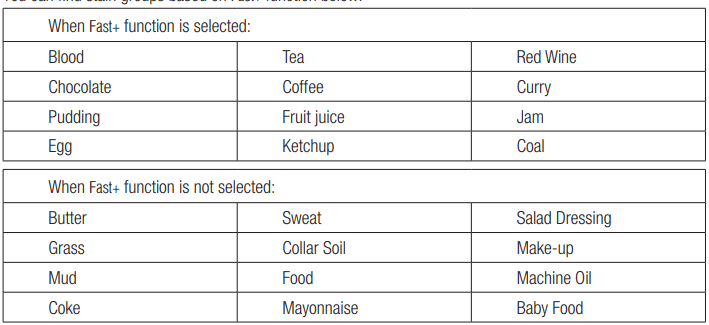
- Select the stain programme.
- Select the stain you want to clean by locating it in the groups above and selecting the related group with the quick auxiliary function button.
- Read the garment tag carefully and ensure that correct temperature and spin speed are selected.
- Downloaded Program
This is a special programme that allows you to download different programmes when you want to. At the start, there is a programme you can see with the HomeWhiz application as default. However, you can use the HomeWhiz application to select a programme from the predetermined programme set, and then change and use it.
- Soft Toys
Soft toys must be washed in a delicate programme due to their delicate fabrics, and the fibre and accessories they contain. Thanks to its delicate washing movements and spinning profile, the soft toys programme protects the toys during washing. It is recommended to use liquid detergent.
Temperature selection

Whenever a new programme is selected, the recommended temperature for the programme appears on the temperature indicator. It is possible that the recommended temperature value is not the maximum temperature that can be selected for the current programme.
Press the Temperature Adjustment button to change the temperature. Temperature decreases gradually.
You can also change the temperature after the washing starts. This change can be made if the washing steps allow it. Changes cannot be made if the steps do not allow it.
Spin speed selection

Whenever a new programme is selected, the recommended spin speed of the selected programme is displayed on the Spin Speed indicator.
Press the Spin Speed Adjustment button to change the spin speed. Spin speed decreases gradually.
Then, depending on the model of the product, "Rinse Hold " and "No Spin " options appear on the display.
If you are not going to unload your laundry immediately after the programme completes, you can use Rinse
Hold function in order to prevent them from getting wrinkled when there is no water in the machine.
This function holds the laundry in the final rinsing water.
- If you want to spin your laundry after the Rinse Hold function:
- Adjust the Spin Speed.
Press Start / Pause / Cancel. The programme will resume. Machine drains the water and spins the laundry.
If you want to drain the water at the end of the programme without spinning, use No Spin function.
You can change the spin speed after the washing starts if the washing steps allow it. Changes cannot be made if the steps do not allow it.
Rinse hold
If you are not going to unload your clothes immediately after the programme completes, you can use rinse hold function to keep your laundry in the final rinsing water in order to prevent them from getting wrinkled hen there is no water in the machine. Press Start / Pause button after this process if you want to drain the water without spinning your laundry. Programme will resume and complete after draining the water.
If you want to spin the laundry held in water, adjust the Spin Speed and press Start / Pause button.
The programme will resume. Water is drained, laundry is spun and the programme is completed.
Auxiliary function selection

Select the desired auxiliary functions before starting the programme. Whenever a programme is selected, icons of the auxiliary function symbol that is selected together with it illuminates.
Also the frames of the auxiliary function selected for the current programme after the washing has started remains illuminated.
Auxiliary functionss
- Fast+
After selecting a programme, you can press the Fast+ Function setting key to shorten the programme duration.
For some programmes, the duration can shorten by over 50%. Despite this, the washing performance is good thanks to the changed algorithm.
Although it varies in each programme, when you press the Fast+ key once, the programme duration decreases to a certain level, and when you press the same key for the second time, it drops to the minimum level. For a better washing performance, do not use the Fast+ setting key when washing heavily soiled laundry. Shorten the programme duration by using the Fast+ key for Moderately and Slightly soiled laundry.
- Pet Hair Removal
This function helps to remove pet hair that remain on your garments more effectively.
When you select this function, Prewash and Extra Rinse steps are added to the normal programme. Thus, washing is performed with more water and the pet hair is removed more effectively.
- Steam
Use this function to reduce the creases and ironing time of a small amount of cotton, synthetic or mixed laundry. This function can be selected on the following cycles (see also Program list on page 13): Cottons, Synthetics, DailyQuick/Quick 14’, DailyQuick/Quick 14’ + Fast+, Bedding & Blanket, Shirts, Mix, DarkWash/ Jeans. This function works better on a small or half load. Vapour is distributed inside the machine during drum rotation. It is normal that steam vapour may not be visible during the cycle.
- Remote Control

You can use this auxiliary function key to connect your product to smart devices. For detailed information, see HomeWhiz Feature and Remote Control Function.
- Customized Programme
This auxiliary function can only be used for Cotton and Synthetics programmes together with the HomeWhiz application. When this auxiliary function is activated, you can add up to 4 auxiliary rinsing steps to the programme. You can select and use some auxiliary functions even though they are not found on your product.
You can increase and decrease the time of the Cottons and Synthetics programmes within a safe range.
Functions/Programmes Selected by Pressing the Function Keys for 3 Seconds
- Drum Clean 3”

Press and hold the auxiliary function button 1 for 3 seconds to select the programme. Use regularly (once in every 1-2 months) to clean the drum and provide the required hygiene. Steam is applied before the programme to soften the residues in the drum. Please note that steam vapour may not be visible during the cycle. Operate the programme while the machine is completely empty. To obtain better results, put powder lime-scale remover for washing machines into the detergent compartment no. „2“. When the programme is over, leave the loading door ajar so that the inside of the machine gets dry.
- Anti-Crease+ 3”

This function is selected when the spin selection button is pressed and held for 3 seconds and the programme follow-up light for the relevant step turns on. When the function is selected, the drum rotates for up to 8 hours for preventing the laundry from creasing at the end of the programme. You can cancel the programme and take your laundry out at any time during the 8-hour duration. Press the function selection key or the machine on/off key to cancel the function. The programme follow-up light will remain on until the function is canceled or the step is complete. If the function is not cancelled, it will be active in the subsequent washing cycles as well.
- Night Mode 3”

This function is selected when the auxiliary function button 2 is pressed and held for 3 seconds.
Use to wash the cottons with lesser energy consumption and silently. Spin steps are cancelled for a silent washing and the cycle ends with the Rinse Hold step. After completion of the programme, run Spin cycle to spin the laundry
- Child lock

Use Child Lock function to prevent children from tampering with the machine. Thus you can avoid any changes in a running programme.
To activate the Child Lock:
Press and hold Auxiliary Function button 3 for 3 seconds. After the countdown as “CL 3-2-1" on the display is over, "CL On" symbol appears on the display. When this warning is displayed, you can release the
Auxiliary Function button 3.
To deactivate the Child Lock:
Press and hold Auxiliary Function button 3 for 3 seconds. After the countdown as “CL 3-2-1" on the display is over, "CL Off" symbol disappears.
- Bluetooth 3’’

You can use the bluetooth connection function to pair your machine with your smart device. This way, you can use your smart device to get information about your machine and control it.
To activate bluetooth connection:
Press and hold Remote Control function button for 3 seconds. Countdown “3-2-1” will be displayed, and then “On” icon will appear on the display. Release Remote Control function button. The bluetooth icon will flash while the product is pairing with smart device. If connection is successful, icon will remain on.
To deactivate bluetooth connection:
Press and hold Remote Control function button for 3 seconds. Countdown “3-2-1” will be displayed, and then “Off” icon will appear on the display
End Time
Time display
Remaining time for the completion of the programme while it is running is displayed as “01:30” in hours and minutes format.
With the End Time function, the startup of the programme may be delayed up to 24 hours. After pressing End Time button, the programme's estimated ending time is displayed. If the End Time is set, End Time indicator is illuminated.

In order for the End Time function is activated and the programme is completed at the end of the specified time, you must press Start/Pause button after adjusting the time.

If you want to cancel End Time function, turn the knob to on and off position. machine
- Open the loading door, place the laundry and put detergent, etc.
- Select the washing programme, temperature, spin speed and, if required, the auxiliary functions.
- Set the end time of your choice by pressing the End Time button. End Time indicator illuminates.
- Press Start / Pause button. Time countdown starts. “:” sign in the middle of the end time on the display starts flashing.
Starting the programme
1. Press Start / Pause button to start the programme.
2. The Start / Pause button's light which was off before starts to illuminate steadily now, indicating that the programme has started .

3. Loading door is locked. The door lock symbol appears on the display after the loading door is locked.

4.Programme follow-up indicator lights on the display will show the current programme step.
Loading door lock
There is a locking system on the loading door of the machine that prevents opening of the loading door in cases when the water level is unsuitable.
Door Locked" symbol appears on the display when the loading door is locked.

Opening the loading door in case of power failure
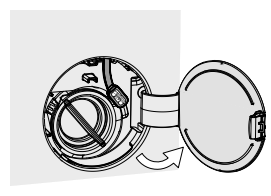
- Open the pump filter cap
- Release the loading door emergency handle located at the rear side of the filter cap.
- Pull down the loading door emergency handle once and open the loading door. After opening the loading door, re-insert the loading door emergency handle.
- If the loading door does not open, try again by pulling down the handle

Changing the selections after programme has started
Adding laundry after the programme has started :
If the water level in the machine is suitable when you press Start/Pause button, the door lock will be deactivated and the door will open, allowing you to add garments. The door lock icon on the display goes off when the door lock is deactivated. After adding garments, close the door and press Start/Pause button once again to resume the washing cycle.

If the water level in the machine is not suitable when you press Start/Pause button, the door lock cannot be deactivated and the door lock icon on the display remains on.

Switching the machine to pause mode:
Press the Start/Pause button to switch the machine to pause mode. Pause symbol will flash on the display.

Changing the programme selection after programme has started:
The programme change is allowed when the current programme is running unless the Child Lock is enabled.
This action will cancel the current programme.
Changing the auxiliary function, speed and temperature
Depending on the step the programme has reached, you can cancel or activate the auxiliary functions. See “Auxiliary function selection”
You can also change the speed and temperature settings. See "Speed selection" and "Temperature selection".
Cancelling the programme
The programme is cancelled when program selection knob is turned to a different programme or machine is turned off and on again using the program selection knob.
End of programme
End symbol appears on the display when the programme is completed.
If you do not press any button for 10 minutes, the machine will switch to OFF mode. Display and all indicators are turned off.
Completed programme steps will be displayed if you press On/Off button.
HomeWhiz Feature and Remote Control Function
HomeWhiz allows you to use your smart device to check your washing machine and get information about its status. With HomeWhiz application you can use your smart device to perform various procedures that can also be performed on the machine. Plus, you can use some features only with the HomeWhiz function.
You must download the HomeWhiz application from the app store of your smart device to use the bluetooth feature of your machine.
Make sure that your smart device is connected to internet to install the app.
If you are using the app for the first time, please follow the on-screen instructions to complete your user account registration. Once the registration procedure is complete, you can use all products with the HomeWhiz feature in your house on this account.
You can touch "Add/Remove Appliance" HomeWhiz application to see the products paired with your account.
You can perform user pairing procedures of these products on this page.
HomeWhiz Setup
In order for the application to run, a connection between your appliance and the HomeWhiz Application must be established. For this connection to be established you must follow the steps below for setup procedure on both the appliance and the HomeWhiz Application.
- If you are adding an appliance for the first time, tap „Add/Remove Appliance“ button on the HomeWhiz Application. After this step tap „Tap here to setup a new appliance“. Follow steps below as well as steps in the Homewhiz Application to perform the setup.
- To start the setup, make sure that your machine is turned off. Press and hold the Temperature button and the Remote Control Function button simultaneously for 3 seconds to switch your machine to HomeWhiz setup mode.

- When the appliance is in HomeWhiz setup mode, you will see an animation on the display and the bluetooth icon will flash until your machine gets paired with smart device. Only programme knob will be active in this mode. Other buttons will be inactive.

- On the screen you see on the app, select the washing machine and press next.
- Proceed reading the on-screen instructions until HomeWhiz asks you about the product you wish to connect to your smart device.
- If your washing machine successfully paires with your device, your display will automatically turn on in the normal mode and the bluetooth icon will remain on as you hear a setup successful melody from the appliance.
- Return to the HomeWhiz application and wait until the setup is complete. When setup is complete, give your washing machine a name. Now, you can tap and see the product you have added in the HomeWhiz Aplication.
Setting up a washing machine that is connected to someone else's account
If the washing machine you want to use was previously introduced to the system with someone else‘s account, you must establish a new connection between your HomeWhiz Application and the appliance.
- Download HomeWhiz Application on the new smart device you want to use.
- Create a new account and log in to this account on the HomeWhiz app.
- Follow the steps described in HomeWhiz Setup (4.3.15.1 HomeWhiz Setup) and proceed with the setup procedure.
Remote Control function and its use
After HomeWhiz setup, bluetooth will automatically turn on. To activate or deactivate the bluetooth connection, please see 4.3.8.2 Bluetooth 3’’’.
If you turn off and on your machine while bluetooth is active, it will automatically reconnect. In cases such as paired device going off the range, bluetooth will automatically turn off. For this reason, you will need to turn on the bluetooth again if you want to use the Remote Control function.
You can check the bluetooth symbol on the display to track your connection status. If the symbol is continuously on, you have bluetooth connection. If the symbol is flashing, the product is trying to connect. If the symbol is off, you have no connection.
When you want to control your washing machine remotely, you need to activate the Remote Control function by pressing the Remote Control button while the programme knob is in the Download Program/Remote Control position button on the control panel of your washing machine. When your product is accessed, you will see a screen similar to the below.

When the Remote Control is on, you can only manage, turn-off and status follow-up operations through your washing machine. And all functions except child lock can be managed through the application.
You can follow whether the Remote Control function is On or Off through the function indicator on the button.
If the Remote Control function is Off, all the operations are handled on the washing machine and only status follow-up is allowed on the application.
In the event that Remote Start function cannot be turned on, appliance will make a warning sound when you press the button. This might happen in cases such as when the appliance is turned on and there is no paired smart device via bluetooth. Bluetooth settings being Off or the washing machine's door being open are examples for such cases.
Once you activate this function on the washing machine, it will remain enabled apart from certain conditions and allow you to control your washing mahine remotely via bluetooth.
In certain cases, it deactivates itself for safety reasons:
- When your washing machine undergoes a power interruption.
- When programme knob is turned and a different program selected or appliance is turned off.
Troubleshooting
Do the following if you have a problem with controlling or connection. Observe whether the problem persists or not after the action you have performed. Do the following if the problem is not resolved.
- Check whether your smart device is connected to the relevant home network.
- Restart the product application.
- Turn bluetooth off and then on via user control panel.
- If the connection cannot be established with the above processes, repeat the initial set-up settings on the washing machine.
If the problem persists, consult an Authorised Service Agent.
Maintenance and cleaning
Service life of product extends and frequently experienced problems will be reduced if it is cleaned at regular intervals.
Cleaning the detergent drawer
Clean the detergent drawer at regular intervals (every 4-5 washing cycles) as shown below in order to prevent accumulation of powder detergent in time.
Lift the rear part of the siphon to remove it as illustrated.
If more than normal amount of water and softener mixture starts to gather in the softener compartment, the siphon must be cleaned.

- Press the dotted point on the siphon in the softener compartment and pull towards you until the compartment is removed from the machine.
- Wash the detergent drawer and the siphon with plenty of lukewarm water in a washbasin. In order to prevent the residues to contact your skin, clean it with an appropriate brush by wearing a pair of gloves.
- Insert the drawer back into its place after cleaning and make sure that it is seated well.
Cleaning the loading door and the drum
For products with drum cleaning programme, please see Operating the product - Programmes.
After every washing make sure that no foreign substance is left in the drum.
If the holes on the bellow shown in the figure is blocked, open the holes using a toothpick.
Foreign metal substances will cause rust stains in the drum. Clean the stains on the drum surface by using cleaning agents for stainless steel.
Never use steel wool or wire wool. These will damage the painted, chromated and plastic surfaces.
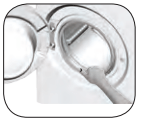
Cleaning the body and control panel
Wipe the body of the machine with soapy water or non-corrosive mild gel detergents as necessary, and dry with a soft cloth.
Use only a soft and damp cloth to clean the control panel.
Cleaning the water intake filters
There is a filter at the end of each water intake valve at the rear of the machine and also at the end of each water intake hose where they are connected to the tap. These filters prevent foreign substances and dirt in the water to enter the washing machine. Filters should be cleaned as they do get dirty. lters should be cleaned as they do get dirty.

- Close the taps.
- Remove the nuts of the water intake hoses to access the filters on the water intake valves. Clean them with an appropriate brush. If the filters are too dirty, remove them from their places with a pliers and clean in this way.
- Take out the filters on the flat ends of the water intake hoses together with the gaskets and clean thoroughly under running water.
- Replace the seals and filters carefully and tighten their nuts by hand.
Draining remaining water and cleaning the pump filter
The filter system in your machine prevents solid items such as buttons, coins and fabric fibers clogging the pump impeller during discharge of washing water. Thus, the water will be discharged without any problem and the service life of the pump will extend.
If the machine fails to drain water, the pump filter is clogged. Filter must be cleaned whenever it is clogged or in every 3 months. Water must be drained off first to clean the pump filter.
In addition, prior to transporting the machine (e.g., when moving to another house) and in case of freezing of the water, water may have to be drained completely
In order to clean the dirty filter and discharge the water:
1.Unplug the machine to cut off the supply power.
2.Open the filter cover.

3.Follow the below procedures in order to drain water.
The product has an emergency water draining hose, in order to drain the water:

a Pull the emergency draining hose out from its seat
b Place a large container at the end of the hose. Drain the water into the container by pulling out the plug at the end of the hose. When the container is full, block the inlet of the hose by replacing the plug. After the container is emptied, repeat the above procedure to drain the water in the machine completely.
c When draining of water is finished, close the end by the plug again and fix the hose in its place.
d Turn and remove the pump filter.
4.Clean any residues inside the filter as well as fibers, if any, around the pump impeller region.
5.Replace the filter.
6.If the filter cap is composed of two pieces, close the filter cap by pressing on the tab. If it is one piece, seat the tabs in the lower part into their places first, and then press the upper part to close.
Troubleshooting
Programs do not start after the loading door is closed.
- Start / Pause / Cancel button is not pressed
- Press Start / Pause / Cancel button.
- It may be difficult to close the loading door in case of excessive loading.
- Reduce the amount of laundry and make sure that the loading door is closed properly.
Programme cannot be started or selected.
- The product has switched to self protection mode due to a supply problem (line voltage, water pressure, etc.).
- To cancel the programme, turn the Programme Selection knob to select another programme.Previous programme will be canceled. (see.“Cancellation of program”)
Water inside the product.
- Some water has remained in the product due to the quality control processes in the production.
- This is not a failure; water is not harmful to the product.
The product does not take water in.
- Tap is turned off.
- Turn on the taps.
- Water inlet hose is bent.
- Flatten the hose.
- Water inlet filter is clogged.
- Clean the filter.
- Loading door is not closed.
- Close the door.
The product does not drain water.
- Water drain hose is clogged or twisted.
- Clean or flatten the hose.
- Pump filter is clogged.
- Clean the pump filter
Product vibrates or makes noise.
- Product is standing unbalanced.
- Stable the product by adjusting the feet.
- A hard substance has entered into the pump filter.
- Clean the pump filter.
- Transportation safety bolts are not removed.
- Remove the transportation safety bolts.
- Laundry quantity in the product is too little.
- Add more laundry to the product.
- Excessive laundry is loaded in the product.
- Take out some of the laundry from the product or distribute the load by hand to balance it homogeneously in the product.
- Product is leaning on a rigid item.
- Make sure that the product is not leaning on anything.
There is water leaking from the bottom of the product.
- Water drain hose is clogged or twisted.
- Clean or flatten the hose.
- Pump filter is clogged.
- Clean the pump filter.
Product stopped shortly after the programme started.
- Machine has stopped temporarily due to low voltage.
- Product will resume running when the voltage restores to the normal level.
Product directly drains the water it takes in.
- Draining hose is not at adequate height.
- Connect the water draining hose as described in the user manual.
No water can be seen in the product during washing.
- Water is inside the invisible part of the product.
- This is not a failure.
Loading door cannot be opened.
- Loading door lock is activated because of the water level in the product.
- Drain the water by running the Pump or Spin programme.
- Product is heating up the water or it is at the spinning cycle.
- Wait until the programme completes.
- Loading door may be stuck because of the pressure it is subjected to.
- Grab the handle and push and pull the loading door to release and open it.
- If there is no power, loading door of the product will not open.
- To open the loading door, open the pump filter cap and pull down the emergency handle positioned at the rear side of the said cap. See "Loading door lock
Washing takes longer than specified in the user manual.(*)
- Water pressure is low.
- Product waits until taking in adequate amount of water to prevent poor washing quality due to the decreased amount of water. Therefore, the washing time extends.
- Voltage is low.
- Washing time is prolonged to avoid poor washing results when the supply voltage is low
- Input temperature of water is low.
- Required time to heat up the water extends in cold seasons. Also, washing time can be lengthened to avoid poor washing results.
- Number of rinses and/or amount of rinse water have increased.
- Product increases the amount of rinse water when good rinsing is needed and adds an extra rinsing step if necessary.
- Excessive foam has occurred and automatic foam absorption system has been activated due to too much detergent usage.
- Use recommended amount of detergent.
Programme time does not countdown. (On models with display) (*)
- Timer may stop during water intake.
- Timer indicator will not countdown until the product takes in adequate amount of water. The product will wait until there is sufficient amount of water to avoid poor washing results due to lack of water. Timer indicator will resume countdown after this.
- Timer may stop during heating step.
- Timer indicator will not countdown until the product reaches the selected temperature.
- Timer may stop during spinning step.
- Automatic unbalanced load detection system is activated due to the unbalanced distribution of the laundry in the product.
Programme time does not countdown. (*)
- There is unbalanced load in the product.
- Automatic unbalanced load detection system is activated due to the unbalanced distribution of the laundry in the product.
Product does not switch to spinning step. (*)
- There is unbalanced load in the product.
- Automatic unbalanced load detection system is activated due to the unbalanced distribution of the laundry in the product.
- The product will not spin if water is not drained completely.
- Check the filter and the draining hose.
- Excessive foam has occurred and automatic foam absorption system has been activated due to too much detergent usage.
- Use recommended amount of detergent.
Washing performance is poor: Laundry turns gray. (**)
- Insufficient amount of detergent has been used over a long period of time.
- Use the recommended amount of detergent appropriate for water hardness and the laundry.
- Washing has been made at low temperatures for a long time.
- Select the proper temperature for the laundry to be washed.
- Insufficient amount of detergent is used with hard water.
- Using insufficient amount of detergent with hard water causes the soil to stick on the cloth and this turns the cloth into gray in time. It is difficult to eliminate graying once it happens. Use the recommended amount of detergent appropriate for water hardness and the laundry.
- Excessive amount of detergent is used.
- Use the recommended amount of detergent appropriate for water hardness and the laundry.
Washing performance is poor: Stains persist or the laundry is not whitened. (**)
- Insufficient amount of detergent is used.
- Use the recommended amount of detergent appropriate for water hardness and the laundry.
- Excessive laundry is loaded in.
- Do not load the product in excess. Load with amounts recommended in the "Programme and consumption table".
- Wrong programme and temperature were selected.
- Select the proper programme and temperature for the laundry to be washed.
- Wrong type of detergent is used.
- Use original detergent appropriate for the product.
- Excessive amount of detergent is used.
- Put the detergent in the correct compartment. Do not mix the bleaching agent and the detergent with each other.
Washing performance is poor: Oily stains appeared on the laundry. (**)
- Regular drum cleaning is not applied.
- Clean the drum regularly. For this procedure, please see "Cleaning the loading door and the drum"
Washing performance is poor: Clothes smell unpleasantly. (**)
- Odours and bacteria layers are formed on the drum as a result of continuous washing at lower temperatures and/or in short programmes.
- Leave the detergent drawer as well as the loading door of the product ajar after each washing.Thus, a humid environment favorable for bacteria cannot occur in the machine.
Colour of the clothes faded. (**)
- Excessive laundry was loaded in.
- Do not load the product in excess.
- Detergent in use is damp.
- Keep detergents closed in an environment free of humidity and do not expose them to excessive temperatures.
- A higher temperature was selected.
- Select the proper programme and temperature according to the type and soiling degree of the laundry.
Washing machine does not rinse well.
- The amount, brand and storage conditions of the detergent used are inappropriate.
- Use a detergent appropriate for the washing machine and your laundry. Keep detergents closed in an environment free of humidity and do not expose them to excessive temperatures.
- Detergent was put in the wrong compartment.
- If detergent is put in the prewash compartment although prewash cycle is not selected, the product can take this detergent during rinsing or softener step. Put the detergent in the correct compartment.
- Pump filter is clogged.
- Check the filter.
- Drain hose is folded.
- Check the drain hose
Laundry became stiff after washing. (**)
- Insufficient amount of detergent is used.
- Using insufficient amount of detergent for the water hardness can cause the laundry to become stiff in time. Use appropriate amount of detergent according to the water hardness.
- Detergent was put in the wrong compartment.
- If detergent is put in the prewash compartment although prewash cycle is not selected, the product can take this detergent during rinsing or softener step. Put the detergent in the correct compartment.
- Detergent was mixed with the softener.
- Do not mix the softener with detergent. Wash and clean the drawer with hot water.
Laundry does not smell like the softener. (**)
- Detergent was put in the wrong compartment.
- If detergent is put in the prewash compartment although prewash cycle is not selected, the product can take this detergent during rinsing or softener step. Wash and clean the drawer with hot water. Put the detergent in the correct compartment.
- Detergent was mixed with the softener.
- Do not mix the softener with detergent. Wash and clean the drawer with hot water.
Detergent residue in the detergent drawer. (**)
- Detergent was put in wet drawer.
- Dry the detergent drawer before putting in detergent.
- Detergent has gotten damp.
- Keep detergents closed in an environment free of humidity and do not expose them to excessive temperatures.
- Water pressure is low.
- Check the water pressure.
- The detergent in the main wash compartment got wet while taking in the prewash water. Holes of the detergent compartment are blocked.
- Check the holes and clean if they are clogged.
- There is a problem with the detergent drawer valves.
- Call the Authorised Service Agent.
- Detergent was mixed with the softener.
- Do not mix the softener with detergent. Wash and clean the drawer with hot water.
- Regular drum cleaning is not applied.
- Clean the drum regularly. For this procedure, please see "Cleaning the loading door and the drum"
Too much foam forms inside the product. (**)
- Improper detergents for the washing machine is used.
- Use detergents appropriate for the washing machine.
- Excessive amount of detergent is used.
- Use only sufficient amount of detergent.
- Detergent was stored under improper conditions.
- Store detergent in a closed and dry location. Do not store in excessively hot places.
- Some meshed laundry such as tulle may foam too much because of their texture.
- Use smaller amounts of detergent for this type of item.
- Detergent was put in the wrong compartment.
- Put the detergent in the correct compartment.
- Softener is being taken early by the product.
- There may be problem in the valves or in the detergent drawer. Call the Authorised Service Agent.
Foam is overflowing from the detergent drawer.
- Too much detergent is used.
- Mix 1 tablespoonful softener and ½ l water and pour into the main wash compartment of the detergent drawer.
- Put detergent into the product suitable for the programmes and maximum loads indicated in the “Programme and consumption table”. When you use additional chemicals (stain removers, bleaches and etc.), reduce the amount of detergent.
Laundry remains wet at the end of the programme. (*)
- Excessive foam has occurred and automatic foam absorption system has been activated due to too much detergent usage.
- Use recommended amount of detergent.
(*) The product does not switch to spinning step when the laundry is not evenly distributed in the drum to prevent any damage to the product and to its surrounding environment. Laundry should be rearranged and re-spun.
(**) Regular drum cleaning is not applied. Clean the drum regularly. See 4.4.2
See other models: VRT 82821 BV CEG5311X BFTF2715SSIM BBO60S1PB HSA46330
